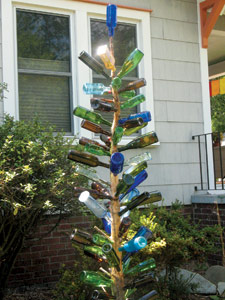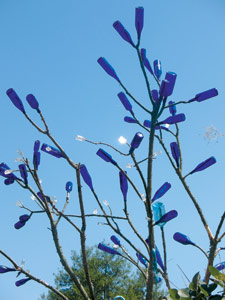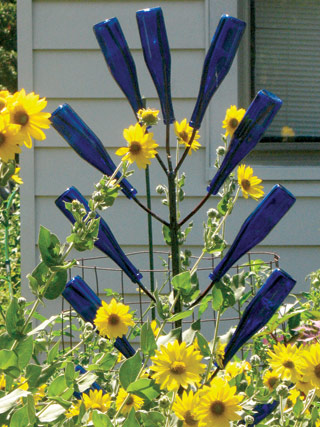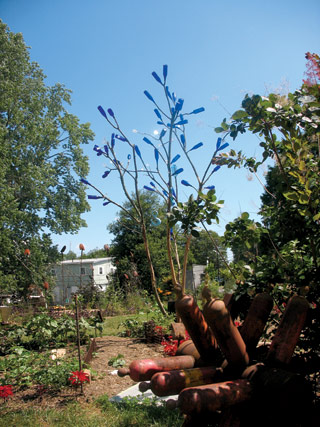The effect falls somewhere between the frail whimsy of a plastic Easter-egg tree and the solemn thrill of a cathedral window. Like their egg-festooned counterparts that appear in early spring, bottle trees are meant for bare branches. And like stained glass, they look most grand after sucking up sunlight.

However, bottle trees hold a solid little back story all their own. The tradition allegedly flourished in the mad, wet heat of the South Carolina and Georgia sea islands, in the steamy Mississippi Delta — a bottle tree is mentioned in Eudora Welty’s short story “Livvie” — and in our own area of the Appalachians. Tennessee native Harrietta “Harry” Deaton, an award-winning interior designer from Hendersonville, will plant a bottle tree outside a renovated Victorian estate in Flat Rock. Built by the French consul of antebellum Charleston, the house is set to open next month as a showcase for area home stagers.
“I have always found the look of blue glass magical, but never really knew why until I started to become interested in the Gullah low-country culture,” says Deaton. All American versions are derived from the bottle tree’s origins in central Africa. As with most vivid forms of folk art (an example is the tourist co-opted hex signs begun on barns in Pennsylvania-Dutch country), superstition is the central tenet: it was believed that the bottles snagged and redirected evil spirits, thus preventing them from entering the house.
Trendily revived glass “witch balls” (hung in windows) and flask-like witch bottles operate on a similar premise. Local writer, witch and WNC native Byron Ballard points out that such ancient devices “are good for [trapping] ghosts, but also for any kind of malign stuff. They will even help turn a direct spell, particularly if the caster isn't very good.”
Mostly, though, it’s about calculated whimsy — think Tibetan prayer flags or chainsaw bear sculptures. Today, bottle trees serve more as hip yard art than as serious ghost busters. And you don’t have to wait for your ailing dogwood or crepe myrtle to die to start decorating its barren branches: hand-carved wooden and welded-metal tree skeletons are a cottage industry backed by considerable pride.

One Mississippi man, blues musician Dudley Pleasants, has crowned himself “The Bottle-Tree Man,” making and selling tree bases whose dimensions run from “baby” to “wicked.” It’s also the sort of DIY project any artsy Ashevillean with moderate skills could pull off.
Some tree merchants even sell ornamental bottles in various colors, but that seems like cheating. Cobalt blue is the favored shade — which, for the purist, means scouting antique stores for vintage Milk of Magnesia bottles or else chugging enough German Riesling to accumulate a blue-bottle collection one hangover at a time.
Pictured are some fairly distinctive examples of local bottle trees. Readers should consider keeping up with this particular folk-art revival — lest the craftily repelled spirits of their neighbor’s haunt their own homes.
[Melanie McGee Bianchi is a contributing editor at Carolina Home + Garden.]





One of the cool parts of Chris Mello’s is that many of the bottles are hidden, making them more like treasures rather than explosions…